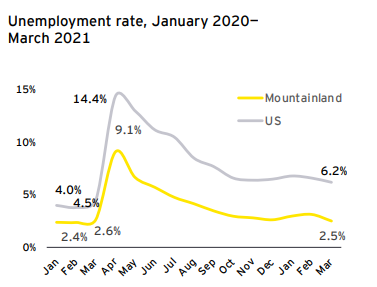COVID-19 Recovery & Resilience
A Framework for Economic Recovery in Summit, Utah, and Wasatch Counties
In 2021 the Mountainland Economic Development District (MEDD) prepared a COVID-19 Economic Recovery and Resilience Plan to assess the impact of the pandemic on regional economic health and evaluate strategies for mitigation, recovery, and long-term growth.
The economic impact of the COVID-19 pandemic in the Mountainland region was less severe than for the State of Utah and the United States overall. The region saw a rapid rise in unemployment in the first months of the pandemic as the economy adjusted, but the region recovered jobs quickly. The resiliency of the Mountainland region's economy is likely due to overall industry diversification across the region, high concentrations of industries that continued to grow during the pandemic, and an overall attractive and supportive business climate.
But hidden behind low unemployment rates and increased retail spending are residents who dropped permanently out of the workforce, industries shuttered by months of devastating loss, and businesses still struggling to operate in the new normal. MEDD is committed to assisting the leaders and policymakers who are working to support these impacted groups. The vision for this economic recovery and resilience plan is simple: a Mountainland region united in strengthening the economic wellbeing of its residents, businesses, and communities.

Although many industries were hit hard by the pandemic, employment in the Mountainland region has rebounded quickly. By March of 2021 unemployment in the three counties was 2.5%, compared to a national average of 6.2%.
While overall job growth has decreased dramatically — falling by 1.0% in Utah and 6.8% nationally — the Mountainland regional has been able to create new jobs despite the challenges of the pandemic.


The labor force across the country has contracted as a result of the pandemic, shrinking by 1.3% nationally. The Mountainland region, by contrast, was able to grow its labor force by 1.8%. Despite positive growth, much work remains to be done in order to meet labor demands and fully recover.
Utah County
 Within the Mountainland region, Utah County experienced fewer relative job losses than the other counties and saw a return to positive growth beginning in July 2020. Unemployment has fallen from a peak of 7.7% in April 2020 to a pre-pandemic level of 2.5% in March 2021. Over this same period, the Utah County labor force grew 2.5% — this is in contrast to a national contraction in the size of the labor force.
Within the Mountainland region, Utah County experienced fewer relative job losses than the other counties and saw a return to positive growth beginning in July 2020. Unemployment has fallen from a peak of 7.7% in April 2020 to a pre-pandemic level of 2.5% in March 2021. Over this same period, the Utah County labor force grew 2.5% — this is in contrast to a national contraction in the size of the labor force. Summit County
 Summit County experienced the greatest job losses, which continued through the most recent available data. Although job growth has not returned to normal, unemployment in Summit County has fallen from a peak of 21.4% in April 2020 to a near pre-pandemic level of 2.8% in March 2021. This is likely due to a large number of people leaving the labor force though, and not from jobs returning or being created.
Summit County experienced the greatest job losses, which continued through the most recent available data. Although job growth has not returned to normal, unemployment in Summit County has fallen from a peak of 21.4% in April 2020 to a near pre-pandemic level of 2.8% in March 2021. This is likely due to a large number of people leaving the labor force though, and not from jobs returning or being created.Wasatch County
 Wasatch County’s economy was less adversely impacted than Summit County's, but still faces challenges in employment. Total employment in recovered to pre-pandemic levels in August 2020 but then experienced a slight dip to 0.9% year-over-year growth in September 2020. Local employment growth has nearly returned to normal, and unemployment has followed a similar trend.
Wasatch County’s economy was less adversely impacted than Summit County's, but still faces challenges in employment. Total employment in recovered to pre-pandemic levels in August 2020 but then experienced a slight dip to 0.9% year-over-year growth in September 2020. Local employment growth has nearly returned to normal, and unemployment has followed a similar trend.Moving Forward
1
Recovery
- Regional recovery task force
- Shared investment and infrastructure plans
- Enhanced capacity for childcare
- Initiatives to upskill and retool workers
- Buy local programs
2
Resiliency
- Regional economic development efforts
- Supply chain continuity and regional buying power
- Capital capacity for entrepreneurship and innovation
- Education efforts surrounding density and workforce housing
3
Preparedness
- Regional pandemic response plan
- Stockpile of PPE and sanitizing supplies
- Repository of leading practices and lessons learned